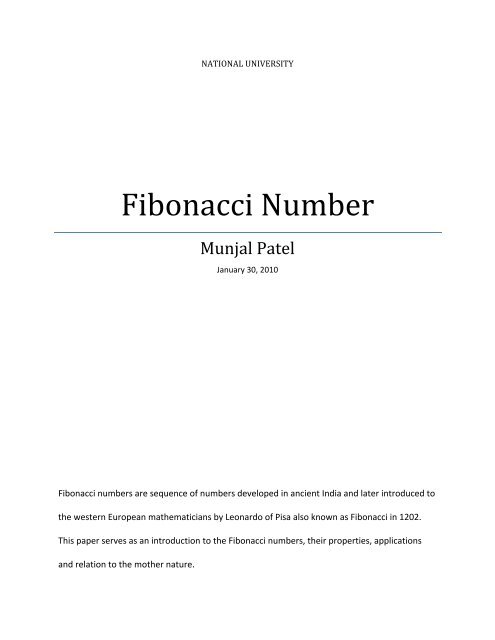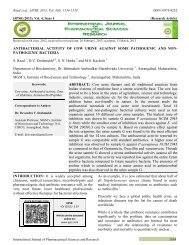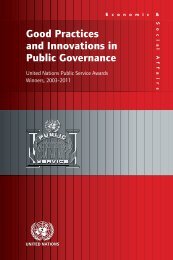fibonacci-numbers
fibonacci-numbers
fibonacci-numbers
You also want an ePaper? Increase the reach of your titles
YUMPU automatically turns print PDFs into web optimized ePapers that Google loves.
NATIONAL UNIVERSITY<br />
Fibonacci Number<br />
Munjal Patel<br />
January 30, 2010<br />
Fibonacci <strong>numbers</strong> are sequence of <strong>numbers</strong> developed in ancient India and later introduced to<br />
the western European mathematicians by Leonardo of Pisa also known as Fibonacci in 1202.<br />
This paper serves as an introduction to the Fibonacci <strong>numbers</strong>, their properties, applications<br />
and relation to the mother nature.
Leonardo Pisano Bogollo, (c. 1170 – c. 1250) known as Leonardo of Pisa, or simply<br />
Fibonacci was an Italian mathematician (Anderson, Frazier, & Popendorf, 1999). He is<br />
considered as the most talented mathematician of the middle ages (Eves, 1990). Fibonacci was<br />
first introduced to the number system we currently use with symbols from 0 to 9 along with the<br />
Fibonacci sequence by Indian merchants when he was in northern Africa (Anderson, Frazier, &<br />
Popendorf, 1999). He then introduced the Fibonacci sequence and the number system we<br />
currently use to the western Europe In his book Liber Abaci in 1202 (Singh, Acharya<br />
Hemachandra and the (so called) Fibonacci Numbers, 1986) (Singh, The So‐called Fibonacci<br />
<strong>numbers</strong> in ancient and medieval India, 1985).<br />
Fibonacci sequence was well known in India and was applied to the metrical sciences<br />
(prosody). Pingala (200 BC), Virahanka (6 th century AD), Gopāla (c.1135 AD), and Hemachandra<br />
(c.1150 AD) are given credits for the development of this sequence (Goonatilake, 1999). In<br />
Sanskrit prosody, long syllables have duration of 2 and short syllables have duration of 1. For<br />
this reason, it is possible to form a pattern of duration by adding a short syllable to the<br />
pattern of duration 1 or a long syllable to the pattern of duration 2. Sanskrit prosodists<br />
proved that the number of patterns of duration is the same as the sum of the previous two<br />
<strong>numbers</strong> in the sequence. It is believed that this is where the motivation for the Fibonacci<br />
sequence came from. Later, algorithms for finding pattern of duration were developed<br />
and the higher‐order Fibonacci <strong>numbers</strong> were discovered. This work has been reviewed by<br />
Donald Knuth in The Art of Computer Programming (Knuth, The Art of Computer Programming,<br />
2006) (Hall, 2007).<br />
Fibonacci <strong>numbers</strong> Page 2
In order to study Fibonacci <strong>numbers</strong>, Fibonacci investigated a problem about growth<br />
rate of rabbit population in a biologically unrealistic situation. The puzzle Fibonacci posed was:<br />
assume that a newly born pair of rabbit, a male and a female is to be mate at the age of one<br />
month to produce another pair of rabbit with a male and a female on the second month.<br />
Assume that rabbits never die and the same cycle repeats every month so that all pairs give<br />
birth to a new pair every month and a newly born pair can start mating from the second month.<br />
How many pairs of rabbit will there be at the end of the year The solution of the problem<br />
looks like the following:<br />
<br />
<br />
<br />
<br />
At the end of the first month, they mate, but there is still one only 1 pair.<br />
At the end of the second month the female produces a new pair making 2 pairs of rabbits.<br />
At the end of the third month, the original female produces a second pair, making 3 pairs.<br />
At the end of the fourth month, the original female has produced another new pair, the<br />
female born two months ago produces her first pair as well, making 5 pairs.<br />
If this cycle continues, at the end of n month, number of pairs will be the sum of number of<br />
pairs in the month 2 and 1. This is same as the Fibonacci number (Knott, Fibonacci<br />
Numbers and Nature, 2008).<br />
The Fibonacci <strong>numbers</strong> are represented by the <strong>numbers</strong> in the following sequence. By<br />
definition, the first two <strong>numbers</strong> in the Fibonacci series are 0 and 1, and the rest are the sum of<br />
the previous two <strong>numbers</strong>.<br />
0, 1, 1, 2, 3, 5, 8, 13, 21, 34, 55, 89, 144, …<br />
Fibonacci <strong>numbers</strong> Page 3
The first 18 Fibonacci <strong>numbers</strong> denoted by for 0,1,2, … ,17 are the following (Knott, The<br />
Fibonacci <strong>numbers</strong>, 2005):<br />
<br />
0 1 1 2 3 5 8 13 21 34 55 89 144 233 377 610 987 1597<br />
The Fibonacci sequence can be represented by a recurrence relation ,<br />
where seeds 0 and 1. The same sequence can also be extended to negative index .<br />
The sequence with negative index …,8,5,3,2,1,1,0,1,1,2,3,5,8,… can be satisfied by<br />
1 .<br />
One of the interesting properties of Fibonacci <strong>numbers</strong> is that every third number in the<br />
sequence is even and every element of the sequence is always a multiple of . for this<br />
reason, Fibonacci sequence satisfies a stronger divisibility property described by (Su)<br />
(Ribenboim, 2000) (Renault, 1996):<br />
gcd , ,<br />
This unremarkable recursive sequence has yet another interesting pattern. The sides of<br />
the squares in the figure 1 correspond to the <strong>numbers</strong> in the Fibonacci sequence and squares<br />
are arranged in the outwardly spiraling pattern. Each rectangle in the image has roughly the<br />
same shape and ratio for their length and width. It is also very interesting to note that as the<br />
sequence of rectangles develops outwards, the ratio of length to width on every step is the<br />
Fibonacci <strong>numbers</strong> Page 4
atio of two successive terms (Platonic Realms). The ratios of these consecutive Fibonacci<br />
<strong>numbers</strong> form another sequence:<br />
1<br />
1 , 2 1 , 3 2 , 5 3 , 8 5 , 13<br />
8 , 21<br />
13 ,…<br />
In 1753, a Scottish mathematician Robert Simson proved that the ratios of successive Fibonacci<br />
<strong>numbers</strong> ⁄ converges to a real number known as the golden ratio () as approaches to<br />
infinity (Wells, 1987).<br />
1<br />
lim<br />
<br />
→ <br />
<br />
√<br />
⁄ <br />
√<br />
, where is the golden ratio.<br />
√<br />
<br />
1.6180339887 … (Sloane)<br />
Figure 1 A tiling with squares whose sides are successive<br />
Fibonacci <strong>numbers</strong> in length<br />
Figure 2 Approximate and true golden spirals. The green<br />
spiral is made from quarter‐circles tangent to the interior of<br />
each square, while the red spiral is a Golden Spiral, a special<br />
type of logarithmic spiral. Overlapping portions appear<br />
yellow. The length of the side of one square divided by that<br />
of the next smaller square is the golden ratio.<br />
Fibonacci <strong>numbers</strong> Page 5
Because |1 | ⁄ √5 1⁄ 2for all 0, the closest integer to ⁄ √5 can be obtained<br />
by the rounding as following:<br />
<br />
, 0 (Tattersall, 2005)<br />
√ <br />
It is possible to test any number whether it belongs to the Fibonacci series of not. As we<br />
know, that the closest integer to is ⁄ √5, the most straightforward and brute‐force test<br />
would be the following identity with is valid if and only if is a Fibonacci number (Posamentier<br />
& Lehmann, 2007).<br />
log √5 1 <br />
2<br />
Alternatively, if and only if either 5 4 or 5 4 is a perfect square, where is a positive<br />
integer, than is also a Fibonacci number (Posamentier & Lehmann, 2007). It is possible to<br />
conduct a more sophisticated test by considering the fact that the convergent of the continued<br />
fraction representation of are ratios of successive Fibonacci <strong>numbers</strong>. The following<br />
inequality is true if and only if ( and are coprime) and and are successive Fibonacci<br />
<strong>numbers</strong> (Posamentier & Lehmann, 2007).<br />
1 <br />
From this, it is possible to derive that is a Fibonacci number if and only if the interval<br />
, contains a positive integer (Möbius, 1998).<br />
<br />
Fibonacci <strong>numbers</strong> Page 6
There are many other properties and identities related to Fibonacci <strong>numbers</strong> and people<br />
have written books about it. Due to the nature of this paper and a limited scope, it is hard to<br />
cover everything there is about for the Fibonacci <strong>numbers</strong>. For this reason, in this final section<br />
of the paper, I will introduce some real world applications related to Fibonacci <strong>numbers</strong> and<br />
their relationship with nature.<br />
Fibonacci <strong>numbers</strong> are important to perform a run‐time analysis of Euclid’s algorithm to<br />
find the greatest common divisor (GCD) of two integers. A pair of two consecutive Fibonacci<br />
<strong>numbers</strong> makes a worst case input for this algorithm (Knuth, Art of Computer Programming,<br />
Volume 1: Fundamental Algorithms, 1997). Fibonacci <strong>numbers</strong> have their application in the<br />
polyphase version of the Merge Sort algorithm. This algorithm divides an unsorted list in two<br />
lists such that the length of lists corresponds to two sequential Fibonacci <strong>numbers</strong>. The ratio of<br />
the lengths of the lists is an approximately same as (Knuth, Art of Computer Programming,<br />
Volume 1: Fundamental Algorithms, 1997). Fibonacci <strong>numbers</strong> are essential in the analysis of<br />
the Fibonacci heap data structures. A network topology for parallel computing uses a Fibonacci<br />
cube which is an undirected graph with Fibonacci number of nodes. The Fibonacci search<br />
technique is a one‐dimensional optimization method and is developed on the basis of Fibonacci<br />
<strong>numbers</strong> and their properties (Avriel & Wilde, 1966). IFF 8SVX audio file format in Amiga<br />
computers uses Fibonacci sequence to compand the original audio wave for optional lossy<br />
compression (Addison‐Wesley, 1991). The conversion factor from miles to kilometers<br />
1.609344 . When Fibonacci <strong>numbers</strong> are replaced by their successors, the sum of the<br />
decomposition of distance in miles into a sum of Fibonacci <strong>numbers</strong> is approximately same as<br />
kilometer sum. This can be achieved by shifting a radix 2 number register in golden ratio base<br />
Fibonacci <strong>numbers</strong> Page 7
. Shifting the register down the Fibonacci number results into the conversion from kilometers<br />
to miles (Hazewinkel, 2002) (Knott, Using the Fibonacci <strong>numbers</strong> to represent whole <strong>numbers</strong>,<br />
2009).<br />
A close observation of our nature revels that Fibonacci <strong>numbers</strong> are often found in two<br />
consecutive Fibonacci <strong>numbers</strong> in biological setting (Douady & Couder, 1995), branching in<br />
trees, and arrangement of leaves on a stem, and the fruitlets of a pineapple (Jones & Wilson,<br />
2006) for example. The flowering of artichoke and arrangements of a pine cone is yet another<br />
example (Brousseau, 1969). The Fibonacci <strong>numbers</strong> have also been observed in the family tree<br />
of honeybees (Thimbleby). H. Vogel in<br />
1979 proposed a model for the pattern of<br />
florets found in the head of a sunflower<br />
(Vogel, 1979) as below:<br />
2 , √<br />
∅ Here, is the index number of the floret<br />
while is a constant scaling factor.<br />
Figure 3 Sunflower head displaying florets in spirals of 34 and 55<br />
around the outside<br />
Therefore, florets lie on Fermat's spiral. The divergence angle is approximately 137.51 ° which is<br />
known as the golden angle because this angle divides a circle in the golden ratio. The reason<br />
sunflower florets pack so efficiently is since this ratio is an irrational number; no floret has a<br />
neighbor at exactly the same angle from the center. The rational approximations to the golden<br />
ratio are of form : 1. For this reason, the nearest possible neighbor of floret number<br />
are those at for some index which is dependent of , the distance from the center.<br />
Fibonacci <strong>numbers</strong> Page 8
It is often observed that sunflowers and similar natural arrangements have 55 spirals in one<br />
direction while 89 in the other (Prusinkiewicz & Lindenmayer, 1991).<br />
Once again I would like to stress that this paper shall only be considered as the<br />
introduction to the Fibonacci <strong>numbers</strong> and there is still much more to Fibonacci <strong>numbers</strong> not<br />
covered in this paper.<br />
Fibonacci <strong>numbers</strong> Page 9
References<br />
Addison‐Wesley. (1991). Amiga ROM Kernel Reference Manual. Addison‐Wesley.<br />
Anderson, M., Frazier, J., & Popendorf, K. (1999). Leonardo Fibonacci (ca.1175 ‐ ca.1240). Retrieved<br />
January 28, 2010, from ThinkQuest: http://library.thinkquest.org/27890/biographies1.html<br />
Avriel, M., & Wilde, D. J. (1966). Optimality of the Symmetric Fibonacci Search Technique. Fibonacci<br />
Quarterly, (pp. 265–269).<br />
Brousseau, A. (1969). Fibonacci Statistics in Conifers. Fibonacci Quarterly , 525–532.<br />
Douady, S., & Couder, Y. (1995). Phyllotaxis as a Dynamical Self Organizing Process. Journal of<br />
Theoretical Biology , 255–274.<br />
Eves, H. (1990). An Introduction to the History of Mathematics (6th ed.). Brooks Cole.<br />
Goonatilake, S. (1999). Toward a Global Science: Mining Civilizational Knowledge (Race, Gender, and<br />
Science). Indiana University Press.<br />
Hall, R. W. (2007, October 31). Math for Poets and Drummers. Retrieved January 30, 2010, from Saint<br />
Joseph’s University: http://www.sju.edu/~rhall/mathforpoets.pdf<br />
Hazewinkel, M. (Ed.). (2002). Encyclopaedia of Mathematics.<br />
Jones, J., & Wilson, W. (2006). An Incomplete Education, 3,684 Things You Should Have Learned But<br />
probably Didn't. Ballantine Books.<br />
Knott, R. (2008, December 16). Fibonacci Numbers and Nature. Retrieved January 30, 2010, from The<br />
University of Surrey: http://www.maths.surrey.ac.uk/hostedsites/R.Knott/Fibonacci/fibnat.html#Rabbits<br />
Fibonacci <strong>numbers</strong> Page 10
Knott, R. (2005, August 19). The Fibonacci <strong>numbers</strong>. Retrieved January 30, 2010, from The University of<br />
Surrey: http://www.maths.surrey.ac.uk/hosted‐sites/R.Knott/Fibonacci/fibtable.html<br />
Knott, R. (2009, October 23). Using the Fibonacci <strong>numbers</strong> to represent whole <strong>numbers</strong>. Retrieved<br />
January 30, 2010, from The University of Surrey: http://www.maths.surrey.ac.uk/hostedsites/R.Knott/Fibonacci/fibrep.html#kilos<br />
Knuth, D. E. (1997). Art of Computer Programming, Volume 1: Fundamental Algorithms (3rd ed.).<br />
Addison‐Wesley Professional.<br />
Knuth, D. E. (2006). The Art of Computer Programming. Addison‐Wesley Professional.<br />
Möbius, M. (1998). Wie erkennt man eine Fibonacci Zahl<br />
Platonic Realms. (n.d.). The Fibonacci Sequence. Retrieved January 30, 2010, from Platonic Realms:<br />
http://www.mathacademy.com/pr/prime/articles/fibonac/index.asp<br />
Posamentier, A. S., & Lehmann, I. (2007). The Fabulous Fibonacci Numbers. Prometheus Books.<br />
Prusinkiewicz, P., & Lindenmayer, A. (1991). The Algorithmic Beauty of Plants (1st ed.). Springer.<br />
Renault, M. (1996). Properties of the Fibonacci Sequence. Retrieved January 30, 2010, from Temple<br />
University: http://www.math.temple.edu/~renault/<strong>fibonacci</strong>/thesis.html<br />
Ribenboim, P. (2000). My Numbers, My Friends. Springer‐Verlag.<br />
Singh, P. (1986). Acharya Hemachandra and the (so called) Fibonacci Numbers (Math. Ed. Siwan ed., Vol.<br />
20).<br />
Singh, P. (1985). The So‐called Fibonacci <strong>numbers</strong> in ancient and medieval India (Vol. 12). Historia<br />
Mathematica.<br />
Fibonacci <strong>numbers</strong> Page 11
Sloane, N. J. A001622: Decimal expansion of golden ratio phi (or tau) = (1 + sqrt 5 )/2. AT&T Labs.<br />
Su, F. E. (n.d.). Fibonacci GCD's, please. Retrieved January 30, 2010, from Mudd Math Fun Facts:<br />
http://www.math.hmc.edu/funfacts/ffiles/20004.5.shtml<br />
Tattersall, J. J. (2005). Elementary Number Theory in Nine Chapters (2nd ed.). Cambridge University<br />
Press.<br />
Thimbleby, H. (n.d.). “B–” for The da Vinci Code. Retrieved January 30, 2010, from Swansea University:<br />
http://www.cs.swansea.ac.uk/~csharold/dvc/dvc.pdf<br />
Vogel, H. (1979). A better way to construct the sunflower head. Mathematical Biosciences , 179–189.<br />
Wells, D. (1987). The Penguin Dictionary of Curious and Interesting Numbers. Middlesex, England:<br />
Penguin Books.<br />
Fibonacci <strong>numbers</strong> Page 12









